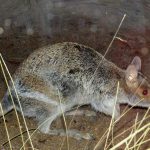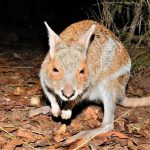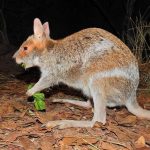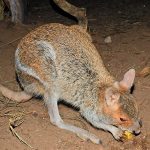SPECTACLED HARE-WALLABY
The Spectacled Hare-Wallaby is a small marsupial and a member of the kangaroo family (Macropodidae). It has a compact body with long hind legs, a long tail, and a relatively short snout. The fur coloration can vary, but it is typically reddish-brown to greyish-brown on the back, with a distinctive pale “spectacle” pattern around the eyes. The underbelly is usually lighter in color. The average adult size is around 40-50 cm in length, and they weigh between 1-1.5 kilograms.
The Spectacled Hare-Wallaby is endemic to Australia and is found in specific regions of northern Queensland. It primarily inhabits dense tropical rainforests, including lowland and upland areas. They prefer areas with thick undergrowth and dense vegetation for cover.
Spectacled Hare-Wallabies are primarily nocturnal and are most active during the night. They are shy and elusive animals, spending much of their time in dense vegetation for cover. They are primarily solitary animals, although they may occasionally come together in small groups. They are skilled jumpers and can move swiftly through their habitat.
The diet of Spectacled Hare-Wallabies consists mainly of plant material. They are herbivorous and feed on a variety of vegetation, including grasses, herbs, leaves, fruits, and flowers. They are selective feeders, choosing the most nutritious parts of plants.
Female Spectacled Hare-Wallabies have a well-developed pouch in which they carry and nurse their young, called joeys. After a gestation period of around 28-30 days, a tiny, undeveloped joey is born. The joey climbs into the pouch, where it continues to develop and nurse from its mother for several months before gradually spending more time outside the pouch.
The Spectacled Hare-Wallaby is currently listed as “Endangered” by the International Union for Conservation of Nature (IUCN). They have experienced significant population declines due to habitat loss, fragmentation, and predation by introduced predators such as dogs, cats and foxes.




